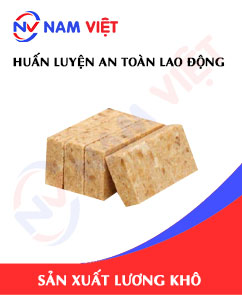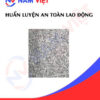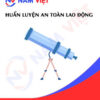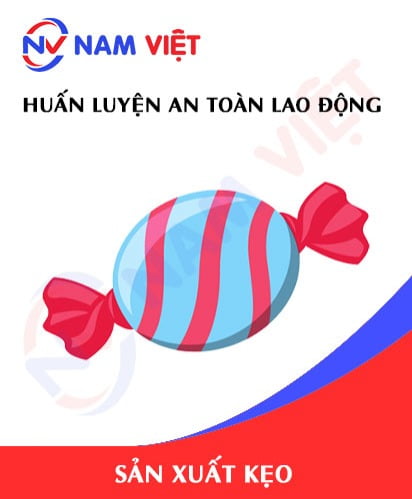Occupational Safety Training for Dry Food Manufacturing
99,000 ₫
Note: The above price is calculated for one person, and the price may fluctuate depending on the number of learners participating in the course and market movements. For more accurate pricing support, please refer to the price list or contact our consulting staff directly.
Occupational safety is an important issue in dry food manufacturing factories and needs to be addressed promptly to ensure the health and safety of workers and enhance the reputation of enterprises. The Occupational Safety Training course is one of the effective solutions to raise awareness on how to prevent workplace accidents for workers participating in dry food manufacturing.
Table of Contents
Toggle1. Overview of dry food
a. What is dry food?
Dry food for the military, known as “MRE” (Meals Ready to Eat) in English, are pre-prepared meals that do not require cooking or adding water. MRE are specially designed to provide nutrition and energy for the military during combat activities or in environments where there are no conditions to prepare fresh food.
Each MRE package includes different components, such as main dishes (meat, fish, chicken, or noodles), side dishes (such as rice, potatoes, or vegetables), bread, jam, snacks, instant drinks, salt, spices, wet wipes, heating pads, and other accessories. MRE can usually be stored for a long time and can be eaten directly from the package or heated using the included heating pouch.
Dry food for the military provides essential nutritional values, meeting energy needs and maintaining soldiers’ health in harsh conditions without fresh food sources.

b. Types of machinery for manufacturing dry food
The types of machinery involved in the dry food manufacturing process include:
- Water press machine: Used to remove water from food ingredients. The water press helps reduce the moisture in food to extend storage time and prevent bacterial growth.
- Drying machine: The drying machine is used to remove moisture from food ingredients. The drying process helps reduce moisture to a safe level, preventing bacterial growth and preserving nutrients.
- Packing machine: Automatic packing machines are used to pack dry food into individual packages or vacuum bags. The packing machine helps protect dry food from contamination and ensures long-term preservation.
- Cutting and grinding machines: For ingredients such as meat, fish, or vegetables, cutting and grinding machines are used to prepare and process them into desired sizes and shapes before pressing and drying.
- Measuring and inspection machines: Measuring and inspection machinery is used to ensure the quality and standards of dry food. These devices can measure moisture, size, weight, and other parameters to ensure product quality.
- Heating machine: Heating machines can be used to warm dry food before consumption, enhancing flavor and providing a better eating experience.
Depending on the scale and manufacturing technology, there may be additional types of machinery and equipment used in the dry food manufacturing process.

c. Dry food manufacturing enterprises in Vietnam
There are several dry food manufacturing enterprises in Vietnam. Here are some examples:
- Vietnam Dry Food Co., Ltd.: This is one of the leading companies in dry food manufacturing in Vietnam. The company provides a variety of dry food products such as stir-fried noodles, rice paper rolls, crab noodle soup cakes, fried shallots, and other dried spices.
- Viet Grain Company Limited: The company specializes in manufacturing dry food from cereals such as rice, wheat, corn, and beans. The company’s products include vermicelli, pho, noodles, and other dry dishes.
- An Khang Food Co., Ltd.: The company specializes in manufacturing dry food from ingredients such as meat, fish, shrimp, and vegetables. The company’s products include crab vermicelli, mixed stir-fried noodles, dried anchovies, and dried vegetables.
- Nhat Huong Food Joint Stock Company: The company specializes in manufacturing traditional dry food and specialty dishes. The company’s products include dried mung bean cakes, sticky rice cakes, green rice cakes, and dried nuts.
These are just a few examples of dry food manufacturing enterprises in Vietnam, and there may be many other businesses operating in this industry.

d. Specific jobs in dry food manufacturing factories
Group 1
- Executive director, deputy executive director, department heads in dry food manufacturing factories.
Group 2
- Safety officer: managing safety in the factory, designing safety procedures, supervising, and urging employees to comply with safe working procedures.
Group 3
- Ingredient preparation: This job involves preparing necessary ingredients for the dry food manufacturing process. It includes checking and processing food components, measuring, and mixing spices and sauces.
- Water pressing: This task involves using water press machines to remove water from food ingredients. The water pressing process helps reduce moisture in food to extend storage time.
- Drying: After water pressing, food is put into the drying machine to remove the remaining moisture. The drying process helps reduce moisture to a safe level and prevents bacterial growth.
- Grinding, cutting, and processing: For ingredients such as meat, fish, and vegetables, this process includes grinding, cutting, and processing them into desired sizes and shapes before pressing and drying.
- Packing: After dry food is manufactured, the packing process is carried out. Automatic packing machines can be used to pack dry food into individual packages or vacuum bags. This packing process helps protect dry food from contamination and ensures long-term preservation.
- Quality control: Quality control is carried out to ensure that dry food meets quality standards. Moisture, size, weight, and other parameters are checked to ensure product quality.
- Cleaning and maintenance: Cleaning and maintenance tasks are performed to maintain cleanliness and the effective operation of machinery in the manufacturing factory.
Group 4
- Office work, service, sales, marketing.
- Production management, quality management, human resource management, material management, financial and accounting management.
- Research and development of new products, packaging design.
2. Overview of occupational safety training for dry food manufacturing
In this article, we focus on issues related to group 3, because group 3 is directly involved in the manufacturing process and faces the highest occupational safety risks. Refer to other groups here
a. What is group 3 occupational safety training?
- Occupational safety training for group 3 are sessions that equip workers with awareness of accident prevention in the workplace.
- The occupational safety training course will help workers recognize and avoid hazards, reducing risks of workplace accidents.
b. Training duration
Initial occupational safety training duration
- Total training duration is at least 24 hours, including test time.
- 8 hours of theory on occupational safety and hygiene laws and policies
- 8 hours of theory on basic occupational safety and hygiene knowledge
- 4 hours of theory on specialized training content
- 2 hours of practice on specialized training content
- 2 hours of theoretical test at the end of the training
The occupational safety training center will divide training time into multiple sessions depending on workers’ schedules. Typically, there will be 6 training sessions, the course lasts 3 days, provided the manufacturing enterprise arranges continuous training time.
Periodic occupational safety training duration
- Before the occupational safety card expires, workers must attend periodic occupational safety training to renew, with periodic training duration equal to at least 50% of the initial training duration.
Explanation: total periodic occupational safety training duration is at least 12 hours, including test time. After completing the periodic training course and passing the test, workers will be reissued and renewed with the occupational safety card.
c. Training content
| No. | TRAINING CONTENT | TRAINING DURATION (HOURS) | |||
| Total | Including | ||||
| Theory | Practice | Test | |||
| I | Occupational safety and hygiene laws and policies | 8 | 8 | 0 | 0 |
| 1 | Overview of the legal system on occupational safety and hygiene. | 6 | 6 | ||
| 2 | Occupational safety and hygiene technical standards and regulations. | 1 | 1 | ||
| 3 | Specific regulations of state management agencies on occupational safety and hygiene when constructing, expanding, or renovating works, facilities for manufacturing, using, preserving, storing, and inspecting types of machines, equipment, materials, and substances with strict occupational safety and hygiene requirements. | 1 | 1 | ||
| II | Basic knowledge of occupational safety and hygiene | 8 | 8 | 0 | 0 |
| 1 | Basic knowledge of hazardous and harmful factors in the workplace. | 4 | 4 | ||
| 2 | Methods of improving working conditions. | 1 | 1 | ||
| 3 | Safety culture in manufacturing and business. | 1 | 1 | ||
| 4 | Rights and obligations of employers and workers; policies and regimes on occupational safety and hygiene for workers; functions and tasks of the safety and hygiene network. | 1 | 1 | ||
| 5 | Occupational safety and hygiene regulations, signs, safety instructions, and the use of safety devices, personal protective equipment; skills in first aid for workplace accidents, and occupational disease prevention. | 1 | 1 | ||
| III | Specialized training content | 6 | 4 | 2 | 0 |
| General knowledge of types of machines, equipment, and substances generating hazardous and harmful factors; analysis, evaluation, risk management of occupational safety and hygiene; safe working procedures with machines, equipment, and substances with strict occupational safety and hygiene requirements. | 6 | 4 | 2 | ||
| IV | Final test on occupational safety training content | 2 | 2 | 0 | 0 |
| Total | 24 | 22 | 2 | ||
See more training content of 6 groups
d. Occupational safety card
After completing the occupational safety training course and passing the test, workers will be issued an occupational safety card (commonly referred to as occupational safety certificate for group 3).
The group 3 safety card clearly states information such as full name, date of birth, job, and specific working environment. It also includes training duration, red stamp, and signature confirming completion of the training course.
According to the safety card issuance regulations specified in Clause 2 Article 24 Decree 44/2016/ND-CP, there are 2 cases:
- In the case where the employer and the worker have a labor contract, the employer must sign, stamp, and affix seals on the safety card for the worker trained in group 3 after attending the occupational safety training course and passing the test.
- In the case where the worker is a freelancer, seasonal worker, without a labor contract, the training unit must sign, stamp, and affix seals on the safety card for the worker after attending the occupational safety training course and passing the test.

3. Identifying hazards affecting workers in dry food manufacturing
Dry food manufacturing can pose several health hazards to workers during the working process. Below are some hazards that need to be identified:
- Risk of burns or injuries when working with heating equipment, water pressing, and meat grinding machines.
- Dry, dusty, and hot working conditions can cause dry skin, dry eyes, and breathing difficulties.
- Risk of infection or toxicity when exposed to food processing chemicals such as bleaching agents, preservatives, and protective substances.
- Prolonged use of machinery and equipment can cause fatigue, back pain, and joint pain.
- If personal protective equipment such as masks, protective glasses, and gloves are not fully worn, workers are at risk of occupational accidents, especially during steps such as cutting meat and using grinders.
- Electrical hazards: If electrical equipment in the factory is not regularly maintained, not properly insulated, and not waterproof, it will cause the risk of electric shock to workers during manufacturing.

4. Common occupational accidents for workers in dry food manufacturing
During the process of dry food manufacturing, there are some common occupational accidents that can affect the health and safety of workers. Below are some common types of occupational accidents in dry food manufacturing:
- Cutting and injury accidents: Cutting devices, sharp knives, and machinery used in the processing and packaging of dry food can cause cutting and injury accidents if safety regulations are not followed and personal protective equipment is not fully used.
- Fire and burn accidents: The drying and heat treatment process in dry food factories poses risks of fire and burn accidents if safety measures are not followed such as using the correct protective equipment, controlling temperature, and managing thermal quality.
- Chemical poisoning: Using preservatives, bleaching agents, and protective substances can cause poisoning for workers if procedures are not properly followed, personal protective equipment is not worn, and hygiene is not ensured during exposure.
- Accidents from inhaling dust and toxic fumes: Working in dry, dusty, and hot environments can generate dust and toxic fumes harmful to the respiratory system of workers. Not wearing protective masks or lacking proper ventilation systems can lead to accidents from inhaling toxic substances.
- Transportation and lifting accidents: During the transportation and lifting of dry food materials and products, accidents such as falls, collisions, and crushing can occur if safety rules are not followed when working with machinery and lifting equipment.
5. Safety measures when participating in dry food manufacturing
When participating in dry food manufacturing, following safety measures is very important to protect the health and safety of workers. Below are some common safety measures in the dry food manufacturing process:
- Occupational safety training: Ensure that all employees participating in dry food manufacturing are trained in occupational safety rules, safe working procedures, and correct use of personal protective equipment.
- Use of personal protective equipment: Ensure that all employees involved in dry food manufacturing fully and correctly use personal protective equipment such as helmets, masks, protective glasses, gloves, protective clothing, safety shoes, etc.
- Fire and explosion risk control: Apply safety measures to prevent fire and explosion risks, including temperature control, fuel management, ensuring safe electrical systems, and using appropriate explosion-proof equipment.
- Chemical management: Ensure that chemicals used in dry food manufacturing are stored, used, and handled safely and according to procedures. Provide information on hazardous substances and instructions on how to use and protect against them.
- Dust and toxic fume risk control: Ensure that air in the factory is controlled and purified to minimize levels of dust and toxic fumes. Wear protective masks and provide effective ventilation systems to prevent accidents from inhaling toxic substances.
- Machinery and equipment control: Ensure that machinery and equipment are used correctly and safely when working with them.
- Regularly organize occupational environment monitoring in factories and enterprises, collect and analyze harmful factors for workers, thereby adjusting to reduce hazardous levels to prevent occupational diseases for them.
6. Benefits of occupational safety training in dry food manufacturing
An Toan Nam Viet provides businesses with great benefits after completing occupational safety training courses in accordance with Decree 44/2016/ND-CP on occupational safety and hygiene, for companies, factories, and enterprises.
- Workers can identify potential risks of occupational accidents and take preventive measures to avoid accidents.
- Businesses can establish risk prevention measures in the process of manufacturing, operation, and maintenance.
- Minimize costs when occupational safety risks occur.
- Undisrupted manufacturing processes help increase labor productivity and product quality.
- Ensure compliance with occupational safety laws, avoiding legal risks.
- Create reputation and professionalism in all aspects, thereby enhancing the brand value of businesses.
The training courses of An Toan Nam Viet are solutions to prevent and combat external impacts on each individual so that they can avoid dangers that may lead to injury or even death.
7. Customer feedback after completing occupational safety training in dry food manufacturing
An Toan Nam Viet has many years of experience in the mission of accompanying many businesses in Vietnam in general and in the southern provinces in particular. That responsibility for An Toan Nam Viet is extremely valuable, which is why occupational safety training is increasingly emphasized and professional. The motivation for An Toan Nam Viet to grow stronger comes from positive feedback and suggestions from businesses. Below are the feedbacks from our partners we have served.
Bac Nam E&C Construction Investment Joint Stock Company
“The first time using the service at An Toan Nam Viet I was very surprised by the enthusiastic 24/7 support of the consulting team. The class organization was very quick and convenient for our company, thank you very much for the service of An Toan Nam Viet!”
Hoa Dat Construction and Trading Joint Stock Company
“The service of An Toan Nam Viet has helped us a lot in simplifying occupational safety and completing safety records for the working process. The consulting team was enthusiastic and timely in answering our questions. 5 stars for An Toan Nam Viet.”
See more customer interviews after using the service of An Toan Nam Viet
8. Occupational safety training capacity of An Toan Nam Viet
An Toan Nam Viet is a prestigious and high-quality occupational safety training center in Vietnam today. With occupational safety training sessions held continuously at manufacturing workshops, factories, or construction sites across the country (63 provinces in Vietnam).
License for occupational safety training
- An Toan Nam Viet has been inspected and certified by the Department of Occupational Safety of the Ministry of Labor, Invalids and Social Affairs to meet the conditions for occupational safety and hygiene training activities. This further strengthens our occupational safety training capacity.

Documents and lectures
- Before occupational safety training documents are included in the occupational safety training courses, they have been reviewed and censored to ensure that lectures are always accurate in knowledge and effective when applied.
- The teaching methods of lecturers are standardized according to the teaching standards of An Toan Nam Viet, which are methods that occupational safety and hygiene training experts have researched and summarized in the teaching process to bring the highest knowledge absorption efficiency for learners.
Facilities
- Controlling factors in the classroom that affect training will increase teaching efficiency and knowledge absorption effectiveness of learners.
- Facilities supporting training courses of ours always provide spacious classrooms that meet standards for area, lighting, training equipment, etc.
9. Nationwide prestigious quality occupational safety training center
At An Toan Nam Viet, we always put our professional dedication to occupational safety training as a top priority. For us, imparting self-protection knowledge to workers so that they have safety tools on their livelihood journey is contributing to building the country.
To ensure effective training, we carefully prepare every detail, no matter how small. From preparing tools, teaching equipment to curriculum, documents, sound, and lighting.
Our occupational safety training lecturers are experts with many years of experience in the field. They even have research projects identifying hazards in all industries and ways to prevent them.
Lectures are summarized from practice and delivered vividly and understandably to workers. These factors help workers feel comfortable during learning and absorb knowledge well. Of course, the knowledge conveyed always complies with Decree 44/2016/ND-CP.
From there, they grasp many measures to prevent dangers and ways to protect themselves. At the same time, they apply it most appropriately in their actual work.
Our occupational safety training center is proud to provide prestigious and professional occupational safety training services with the following advantages:
- Competitive training costs while training quality is still ensured.
- Flexible training schedules in line with the company’s manufacturing situation.
- Quick occupational safety training certification procedures, in accordance with the law.
- Training lecturers are people with many years of experience in the profession.
- Classrooms are controlled for factors affecting training, increasing teaching efficiency and knowledge absorption of learners.
- Lectures are compiled in accordance with occupational safety work in enterprises.
- An Toan Nam Viet works with dedication and professionalism to support customers accurately and quickly.

10. Refer to more occupational safety training documents for dry food manufacturing
- Occupational safety documents for dry food manufacturing
- Occupational safety training document set
- Occupational safety training test set
- Occupational safety training curriculum for dry food manufacturing
- Occupational safety multiple-choice test for dry food manufacturing
1 review for Occupational Safety Training for Dry Food Manufacturing
No comments yet















namchinh.haiphong341
Giảng viên dạy rất sinh động dễ hiểu!